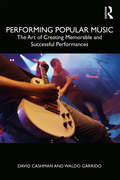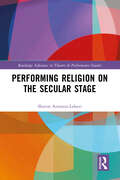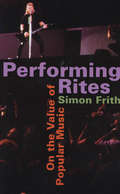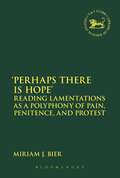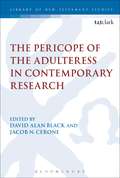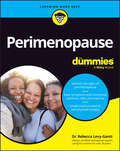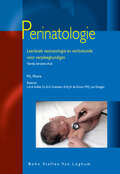- Table View
- List View
Performing Popular Music: The Art of Creating Memorable and Successful Performances
by David Cashman Waldo GarridoThis book explores the fundamentals of popular music performance for students in contemporary music institutions. Drawing on the insights of performance practice research, it discusses the unwritten rules of performances in popular music, what it takes to create a memorable performance, and live popular music as a creative industry. The authors offer a practical overview of topics ranging from rehearsals to stagecraft, and what to do when things go wrong. Chapters on promotion, recordings, and the music industry place performance in the context of building a career. Performing Popular Music introduces aspiring musicians to the elements of crafting compelling performances and succeeding in the world of today’s popular music.
Performing Popular Music: The Art of Creating Memorable and Successful Performances
by David Cashman Waldo GarridoThis book explores the fundamentals of popular music performance for students in contemporary music institutions. Drawing on the insights of performance practice research, it discusses the unwritten rules of performances in popular music, what it takes to create a memorable performance, and live popular music as a creative industry. The authors offer a practical overview of topics ranging from rehearsals to stagecraft, and what to do when things go wrong. Chapters on promotion, recordings, and the music industry place performance in the context of building a career. Performing Popular Music introduces aspiring musicians to the elements of crafting compelling performances and succeeding in the world of today’s popular music.
Performing Religion on the Secular Stage (Routledge Advances in Theatre & Performance Studies)
by Sharon Aronson-LehaviThis book examines the relations between Western religion, secularism, and modern theater and performance. Sharon Aronson-Lehavi posits that the ongoing cultural power of religious texts, icons, and ideas on the one hand and the artistic freedom enabled by secularism and avant-garde experimentalism on the other, has led theatre artists throughout the twentieth century to create a uniquely modern theatrical hybrid–theater performances that simultaneously re-inscribe and grapple with religion and religious performativity. The book compares this phenomenon with medieval forms of religious theater and offers deep and original analyses of significant contemporary works ranging from plays and performances by August Strindberg, Hugo Ball (Dada), Jerzy Grotowski, and Hanoch Levin, to those created by Adrienne Kennedy, Rina Yerushalmi, Deb Margolin, Milo Rau, and Sarah Ruhl. The book analyzes a new and original historiography of a uniquely modern theatrical phenomenon, a study that is of high importance considering the reemergence of religion in contemporary culture and politics.
Performing Religion on the Secular Stage (Routledge Advances in Theatre & Performance Studies)
by Sharon Aronson-LehaviThis book examines the relations between Western religion, secularism, and modern theater and performance. Sharon Aronson-Lehavi posits that the ongoing cultural power of religious texts, icons, and ideas on the one hand and the artistic freedom enabled by secularism and avant-garde experimentalism on the other, has led theatre artists throughout the twentieth century to create a uniquely modern theatrical hybrid–theater performances that simultaneously re-inscribe and grapple with religion and religious performativity. The book compares this phenomenon with medieval forms of religious theater and offers deep and original analyses of significant contemporary works ranging from plays and performances by August Strindberg, Hugo Ball (Dada), Jerzy Grotowski, and Hanoch Levin, to those created by Adrienne Kennedy, Rina Yerushalmi, Deb Margolin, Milo Rau, and Sarah Ruhl. The book analyzes a new and original historiography of a uniquely modern theatrical phenomenon, a study that is of high importance considering the reemergence of religion in contemporary culture and politics.
Performing Rites: On the Value of Popular Music
by Simon FrithAn influential writer on popular music asks what we talk about when we talk about music. Instead of dismissing emotional response and personal taste as inaccessible to academic critics, Frith takes these forms of engagement as his subject—and discloses their place at the center of the aesthetics that structure our culture and color our lives.
The Performing School
by Dennis Gleeson Chris HusbandsThis specially commissioned collection of perspectives offers an analysis of the new organisation of the teaching profession - reconstructed around the notion of performance and the implications of a performance culture. The Performing School examines the roots, directions and implications of the new structure by drawing together insights from policy, research and practice at this time of rapid change and debate. This unique volume addresses three interconnected issues of modernisation and education:*what is the background to and significance of performance management in modernising schools and teachers at the present time?*what are the likely future effects of a performance culture on teaching, learning and schooling?*what will it take to ensure that performance management improves pedagogy and professionality beyond the narrow confines of performativity, managerialism and market reform in education?
The Performing School
by Dennis Gleeson Chris HusbandsThis specially commissioned collection of perspectives offers an analysis of the new organisation of the teaching profession - reconstructed around the notion of performance and the implications of a performance culture. The Performing School examines the roots, directions and implications of the new structure by drawing together insights from policy, research and practice at this time of rapid change and debate. This unique volume addresses three interconnected issues of modernisation and education:*what is the background to and significance of performance management in modernising schools and teachers at the present time?*what are the likely future effects of a performance culture on teaching, learning and schooling?*what will it take to ensure that performance management improves pedagogy and professionality beyond the narrow confines of performativity, managerialism and market reform in education?
Performing Science: Teaching Chemistry, Physics and Biology Through Drama
by Ian Abrahams Martin BraundHow to increase students' interest and engagement in science is a challenge shared by teachers around the world. Designing effective science lesson plans using drama and role play requires expertise across two very different subject areas and, as a consequence, many science teachers find it difficult to incorporate this technique into their teaching. This book provides busy teachers with ready-made lesson plans for teaching many abstract scientific principles in a fun and novel way that really engages students. Drawing on and combining the knowledge of biology, chemistry and physics education specialists with drama education experts, this book covers topics taught widely in the sciences with pupils aged 11-16. The editors and contributors give a broad background to the value of drama and role play in the teaching of science, including a section summarising, for the non-drama specialist, the main techniques that will be used throughout the book. They also provide guidance on how teachers who have enjoyed using the lesson plans within the book can design their own drama and role play activities.
'Perhaps there is Hope': Reading Lamentations as a Polyphony of Pain, Penitence, and Protest (The Library of Hebrew Bible/Old Testament Studies #603)
by Miriam J. BierBier proposes here a strong new understanding of the Book of Lamentations, drawing on Bakhtinian ideas of multiple voices to analyse the poetic speaking voices within the text; examining their theological perspectives, and nuancing the interaction between them. Bier scrutinises interpretations of Lamentations, distinguishing between exegesis that reads Lamentations as a theodicy, in defense of God, and those that read it as an anti-theodicy, in defense of Zion. Rather than reductively adopting either of these approaches, this book advocates a dialogic approach to Lamentations, reading to hear the full polyphony of pain, penitence, and protest.
The Pericope of the Adulteress in Contemporary Research (The Library of New Testament Studies #551)
by David Alan Black Jacob N. CeroneThe contributors to this volume (J.D. Punch, Jennifer Knust, Tommy Wasserman, Chris Keith, Maurice Robinson, and Larry Hurtado) re-examine the Pericope Adulterae (John 7.53-8.11) asking afresh the question of the paragraph's authenticity. Each contributor not only presents the reader with arguments for or against the pericope's authenticity but also with viable theories on how and why the earliest extant manuscripts omit the passage. Readers are encouraged to evaluate manuscript witnesses, scribal tendencies, patristic witnesses, and internal evidence to assess the plausibility of each contributor's proposal. Readers are presented with cutting-edge research on the pericope from both scholarly camps: those who argue for its originality, and those who regard it as a later scribal interpolation. In so doing, the volume brings readers face-to-face with the most recent evidence and arguments (several of which are made here for the first time, with new evidence is brought to the table), allowing readers to engage in the controversy and weigh the evidence for themselves.
The Pericope of the Adulteress in Contemporary Research (The Library of New Testament Studies)
by David Alan Black Jacob N. CeroneThe contributors to this volume (J.D. Punch, Jennifer Knust, Tommy Wasserman, Chris Keith, Maurice Robinson, and Larry Hurtado) re-examine the Pericope Adulterae (John 7.53-8.11) asking afresh the question of the paragraph's authenticity. Each contributor not only presents the reader with arguments for or against the pericope's authenticity but also with viable theories on how and why the earliest extant manuscripts omit the passage. Readers are encouraged to evaluate manuscript witnesses, scribal tendencies, patristic witnesses, and internal evidence to assess the plausibility of each contributor's proposal. Readers are presented with cutting-edge research on the pericope from both scholarly camps: those who argue for its originality, and those who regard it as a later scribal interpolation. In so doing, the volume brings readers face-to-face with the most recent evidence and arguments (several of which are made here for the first time, with new evidence is brought to the table), allowing readers to engage in the controversy and weigh the evidence for themselves.
Perimenopause For Dummies
by Rebecca Levy-GanttGet to know perimenopause and manage troublesome symptoms Perimenopause For Dummies is a practical and comprehensive guide to the emotional, mental, and physical changes that begin to happen as you approach menopause. Demystify the connection between hormones and aging and make informed choices about how to deal with symptoms like weight gain, hot flashes, depression, mood swings, and insomnia. You’ll learn about natural remedies and medical interventions that can ease the transition between fertility and menopause. Most importantly, you’ll know what to expect, so the changes happening in your body won’t take you by surprise. This Dummies guide is like a trusted friend who can guide you through your life’s next chapter. Learn what perimenopause is and identify the most common symptoms Understand how perimenopause can affect your body, emotions, and libido Ease symptoms with hormonal solutions, diet, and exercise Discover ways of supporting yourself or your loved ones through perimenopausePerimenopause For Dummies offers clear, compassionate answers for anyone who is currently experiencing perimenopause or who is ready to learn more about it.
Perimenopause For Dummies
by Rebecca Levy-GanttGet to know perimenopause and manage troublesome symptoms Perimenopause For Dummies is a practical and comprehensive guide to the emotional, mental, and physical changes that begin to happen as you approach menopause. Demystify the connection between hormones and aging and make informed choices about how to deal with symptoms like weight gain, hot flashes, depression, mood swings, and insomnia. You’ll learn about natural remedies and medical interventions that can ease the transition between fertility and menopause. Most importantly, you’ll know what to expect, so the changes happening in your body won’t take you by surprise. This Dummies guide is like a trusted friend who can guide you through your life’s next chapter. Learn what perimenopause is and identify the most common symptoms Understand how perimenopause can affect your body, emotions, and libido Ease symptoms with hormonal solutions, diet, and exercise Discover ways of supporting yourself or your loved ones through perimenopausePerimenopause For Dummies offers clear, compassionate answers for anyone who is currently experiencing perimenopause or who is ready to learn more about it.
Perinatologie: Leerboek neonatologie en verloskunde voor verpleegkundigen (Zorg Rondom)
by M. L. Moore L.A.A. Kollee S. L. VranckenDe perinatologie richt zich op het kind tijdens de ontwikkeling in utero, de geboorte en de eerste levensfase. Snelle ontwikkelingen in de obstetrische en neonatale zorg hebben geleid tot een sterk groeiende belangstelling voor dit vakgebied. Perinatologie is een toegankelijk en praktisch naslagwerk. Aan de orde komen onder meer: kunstmatige voortplantingstechnieken, de embryonale en foetale ontwikkeling, genetische aspecten, de invloed van de omgeving op de foetus, prenatale diagnostiek, HIV-infectie, de bedreigde pasgeborene en tot slot psychosociale en ethische aspecten. Perinatologie is primair geschreven voor verpleegkundigen die werkzaam zijn in de gynaecologie, verloskunde en neonatologie, maar is daarnaast ook voor andere geïnteresseerden een lezenswaardig boek. Perinatologie is gebaseerd op het boek Newborn, family and nurse van M.L. Moore. Dit Amerikaanse boek is vertaald en zorgvuldig aan de Nederlandse gezondheidszorg aangepast. Met deze nieuwe en geactualiseerde uitgave beleeft Perinatologie zijn vierde druk.
The Peripatetic Journey of Teacher Preparation in Canada (Emerald Studies in Teacher Preparation in National and Global Contexts)
by Rosa Bruno-Jofré Joseph StaffordThe Peripatetic Journey of Teacher Preparation in Canada situates teacher training, preparation and education in Canada within national and global histories. The authors lead the reader through an exploration of the objectives of schooling, the contextual role of teachers, and the political undercurrents sustaining various educational conceptions and policies. Taking a ‘longue durée’ approach, the authors begin by considering traditional practices in Indigenous nations encountered by the colonizers of Canada, including the role of the community as an educator. Tracing teacher preparation through colonization, the authors then move on to the formation of the educational state, the development of educational sciences and educational debate, the professionalization of teaching, its feminization at the elementary level, and its integration into the university, along with changes that emerged out of the ‘long 1960s.’ The book closes with a discussion of the process by which Indigenous people are reclaiming control over their education, and with it their spirituality, as well as gaining control over the formation of their own teachers. Placing the historical analysis of teacher preparation within prevailing political and socio-economic processes, the authors showcase a series of overlapping discourses and internationally relevant educational trends.
The Peripatetic Journey of Teacher Preparation in Canada (Emerald Studies in Teacher Preparation in National and Global Contexts)
by Rosa Bruno-Jofré Joseph StaffordThe Peripatetic Journey of Teacher Preparation in Canada situates teacher training, preparation and education in Canada within national and global histories. The authors lead the reader through an exploration of the objectives of schooling, the contextual role of teachers, and the political undercurrents sustaining various educational conceptions and policies. Taking a ‘longue durée’ approach, the authors begin by considering traditional practices in Indigenous nations encountered by the colonizers of Canada, including the role of the community as an educator. Tracing teacher preparation through colonization, the authors then move on to the formation of the educational state, the development of educational sciences and educational debate, the professionalization of teaching, its feminization at the elementary level, and its integration into the university, along with changes that emerged out of the ‘long 1960s.’ The book closes with a discussion of the process by which Indigenous people are reclaiming control over their education, and with it their spirituality, as well as gaining control over the formation of their own teachers. Placing the historical analysis of teacher preparation within prevailing political and socio-economic processes, the authors showcase a series of overlapping discourses and internationally relevant educational trends.
Peripheries at the Centre: Borderland Schooling in Interwar Europe (Studies in Contemporary European History #27)
by Machteld VenkenFollowing the Treaty of Versailles, European nation-states were faced with the challenge of instilling national loyalty in their new borderlands, in which fellow citizens often differed dramatically from one another along religious, linguistic, cultural, or ethnic lines. Peripheries at the Centre compares the experiences of schooling in Upper Silesia in Poland and Eupen, Sankt Vith, and Malmedy in Belgium — border regions detached from the German Empire after the First World War. It demonstrates how newly configured countries envisioned borderland schools and language learning as tools for realizing the imagined peaceful Europe that underscored the political geography of the interwar period.
Peripheries at the Centre: Borderland Schooling in Interwar Europe (Contemporary European History #27)
by Machteld VenkenFollowing the Treaty of Versailles, European nation-states were faced with the challenge of instilling national loyalty in their new borderlands, in which fellow citizens often differed dramatically from one another along religious, linguistic, cultural, or ethnic lines. Peripheries at the Centre compares the experiences of schooling in Upper Silesia in Poland and Eupen, Sankt Vith, and Malmedy in Belgium — border regions detached from the German Empire after the First World War. It demonstrates how newly configured countries envisioned borderland schools and language learning as tools for realizing the imagined peaceful Europe that underscored the political geography of the interwar period.
Peripheries at the Centre: Borderland Schooling in Interwar Europe (Studies in Contemporary European History #27)
by Machteld VenkenFollowing the Treaty of Versailles, European nation-states were faced with the challenge of instilling national loyalty in their new borderlands, in which fellow citizens often differed dramatically from one another along religious, linguistic, cultural, or ethnic lines. Peripheries at the Centre compares the experiences of schooling in Upper Silesia in Poland and Eupen, Sankt Vith, and Malmedy in Belgium — border regions detached from the German Empire after the First World War. It demonstrates how newly configured countries envisioned borderland schools and language learning as tools for realizing the imagined peaceful Europe that underscored the political geography of the interwar period.
Perlen der Mathematik: 20 geometrische Figuren als Ausgangspunkte für mathematische Erkundungsreisen
by Claudi Alsina Roger B. NelsenDieses Buch handelt von 20 geometrischen Figuren (Icons), die eine wichtige Rolle bei der Veranschaulichung mathematischer Beweise spielen. Alsina und Nelsen untersuchen die Mathematik, die hinter diesen Figuren steckt und die sich aus ihnen ableiten lässt.Jedem in diesem Buch behandelten Icons ist ein eigenes Kapitel gewidmet, in dem sein Alltagsbezug, seine wesentlichen mathematischen Eigenschaften sowie seine Bedeutung für visuelle Beweise vieler mathematischer Sätze betont werden. Diese Sätze umfassen unter anderem auch klassische Ergebnisse aus der ebenen Geometrie, Eigenschaften der natürlichen Zahlen, Mittelwerte und Ungleichungen, Beziehungen zwischen Winkelfunktionen, Sätze aus der Differenzial- und Integralrechnung sowie Rätsel aus dem Bereich der Unterhaltungsmathematik. Darüber hinaus enthält jedes Kapitel eine Auswahl an Aufgaben, anhand derer die Leser weitere Eigenschaften und Anwendungen der Diagramme erkunden können.Das Buch ist für alle geschrieben, die Freude an der Mathematik haben; Lehrkräfte und Dozenten der Mathematik werden in diesem Buch sehr nützliche Beispiele für Problemlösungen sowie umfangreiches Unterrichts- und Seminarmaterial zu Beweisen und mathematischer Argumentation finden.
Permanent Crisis: The Humanities in a Disenchanted Age (Studies in the History of the University)
by Paul Reitter Chad WellmonThe humanities, considered by many as irrelevant for modern careers and hopelessly devoid of funding, seem to be in a perpetual state of crisis, at the mercy of modernizing and technological forces that are driving universities towards academic pursuits that pull in grant money and direct students to lucrative careers. But as Paul Reitter and Chad Wellmon show, this crisis isn’t new—in fact, it’s as old as the humanities themselves. Today’s humanities scholars experience and react to basic pressures in ways that are strikingly similar to their nineteenth-century German counterparts. The humanities came into their own as scholars framed their work as a unique resource for resolving crises of meaning and value that threatened other cultural or social goods. The self-understanding of the modern humanities didn’t merely take shape in response to a perceived crisis; it also made crisis a core part of its project. Through this critical, historical perspective, Permanent Crisis can take scholars and anyone who cares about the humanities beyond the usual scolding, exhorting, and hand-wringing into clearer, more effective thinking about the fate of the humanities. Building on ideas from Max Weber and Friedrich Nietzsche to Helen Small and Danielle Allen, Reitter and Wellmon dig into the very idea of the humanities as a way to find meaning and coherence in the world. ,
Permanent Education (Plan Europe 2000, Project 1: Educating Man for the 21st Century #8)
by B. SchwartzPermanent Exclusion from School and Institutional Prejudice: Creating Change Through Critical Bureaucracy (Studies in Inclusive Education #20)
by Anna CarlilePermanent exclusion from school and institutional prejudice Creating change through critical bureaucracy Anna Carlile This book tells the story of permanent exclusion from school from within an urban children's services department. It focuses on two areas: what contributes to instances of permanent exclusion from school, and what the effects are of its existence as a disciplinary option. The book questions how and why local government officers make particular decisions about children and young people. Rather than focussing on what children and young people 'did' behaviourally to 'get excluded', the book adopts a Foucauldian analysis to concentrate on their place within a larger policy-community which includes professionals and policy makers. It adopts a critical-bureaucratic exercise in ‘studying up’ on powerful organisations: an informed approach to ameliorating social inequity. The findings described here suggest a broad, deep and opaque seam of institutional prejudice: permanent exclusion from school can be understood to be both caused by this and to intensify its effects. This has implications for the ‘voices’ of young people subject to or at risk of permanent exclusion from school, and the final chapter outlines a Foucauldian/Freirian ‘student voice’ project, offering ideas about how schools might tackle this.
Permissible Advantage?: The Moral Consequences of Elite Schooling (Sociocultural, Political, and Historical Studies in Education)
by Alan PeshkinThis study of Edgewood Academy--a private, elite college preparatory high school--examines what moral choices look like when they are made by the participants in an exceptionally wealthy school, and what the very existence of a privileged school indicates about American society. It extends Peshkin's ongoing exploration of U.S. high schools and their communities, each focused in a different sociocultural setting. In this particular inquiry, he began with two central questions: * What is a school like whose students enter with a determined disposition to attend college, and all of whom are selected on the promise they display for college success? * What can be learned from studying Edgewood Academy that transcends the particular case of this school? The volume opens with a description of how moral choices look when they are made by the participants in an exceedingly wealthy school. There is a general picture of the Academy, a discussion of the processes the school uses to insure the quality of its students and educators, and an overview of teachers and students that reveals what is commendable about each group. These chapters clarify what a school of ample financial means and wise leadership can do. Peshkin goes on to reflect briefly on privilege and concludes with a discussion of what the very existence of a privileged school indicates about American society. Schools, he suggests, are about much more than what goes on inside them--they mirror what is and is not at stake for their particular constituents--and function similarly for the nation. Edgewood Academy's host community is not a village, town, church, or tribe, as in Peshkin's previous studies. It is a community created by shared aspirations for high-level academic attainment and its associated benefits. Affluence and towering academic achievement are the two most relevant factors. In this book, advantage occupies center stage. The school's excellence is documented not to extol its success, but, rather, to call attention to what is available for its students that is not available for most American children. The focus, ultimately, is on educational justice as illuminated by the advantage of Academy students--that is, on justice denied, not because anyone or any group or agency consciously, planfully sets out to do injustice to other children, but because injustice happens as the artifact of imagined limitations of resources and means. Peshkin's purpose is not to detail the particulars of how educational justice is denied to the many, but to portray and examine the meaning of a privileged school where educational justice prevails for the few.
Permissible Advantage?: The Moral Consequences of Elite Schooling (Sociocultural, Political, and Historical Studies in Education)
by Alan PeshkinThis study of Edgewood Academy--a private, elite college preparatory high school--examines what moral choices look like when they are made by the participants in an exceptionally wealthy school, and what the very existence of a privileged school indicates about American society. It extends Peshkin's ongoing exploration of U.S. high schools and their communities, each focused in a different sociocultural setting. In this particular inquiry, he began with two central questions: * What is a school like whose students enter with a determined disposition to attend college, and all of whom are selected on the promise they display for college success? * What can be learned from studying Edgewood Academy that transcends the particular case of this school? The volume opens with a description of how moral choices look when they are made by the participants in an exceedingly wealthy school. There is a general picture of the Academy, a discussion of the processes the school uses to insure the quality of its students and educators, and an overview of teachers and students that reveals what is commendable about each group. These chapters clarify what a school of ample financial means and wise leadership can do. Peshkin goes on to reflect briefly on privilege and concludes with a discussion of what the very existence of a privileged school indicates about American society. Schools, he suggests, are about much more than what goes on inside them--they mirror what is and is not at stake for their particular constituents--and function similarly for the nation. Edgewood Academy's host community is not a village, town, church, or tribe, as in Peshkin's previous studies. It is a community created by shared aspirations for high-level academic attainment and its associated benefits. Affluence and towering academic achievement are the two most relevant factors. In this book, advantage occupies center stage. The school's excellence is documented not to extol its success, but, rather, to call attention to what is available for its students that is not available for most American children. The focus, ultimately, is on educational justice as illuminated by the advantage of Academy students--that is, on justice denied, not because anyone or any group or agency consciously, planfully sets out to do injustice to other children, but because injustice happens as the artifact of imagined limitations of resources and means. Peshkin's purpose is not to detail the particulars of how educational justice is denied to the many, but to portray and examine the meaning of a privileged school where educational justice prevails for the few.
